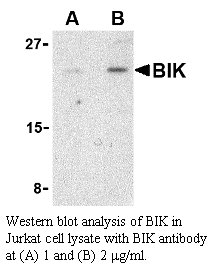Anti-Human Bik
Data
- -
- -
Antibody DetailsProduct DetailsReactive Species Human Host Species Rabbit Immunogen PN:B489 Product Concentration 0.5 mg/ml Formulation This polyclonal antibody is formulated in phosphate buffered saline (PBS) pH 7.4 containing 0.02% sodium azide as a preservative. Storage and Handling This polyclonal antibody is stable for at least one week when stored at 2-8°C. For long term storage, aliquot in working volumes without diluting and store at –20°C in a manual defrost freezer. Avoid Repeated Freeze Thaw Cycles. Country of Origin USA Shipping Next Day Ambient RRIDAB_2828214 Each investigator should determine their own optimal working dilution for specific applications. See directions on lot specific datasheets, as information may periodically change. DescriptionDescriptionSpecificity Rabbit Anti-Human Bik recognizes human and mouse Bik. This polyclonal antibody was purified using affinity chromatography. Background Apoptosis plays a major role in normal organism development, tissue homeostasis, and removal of damaged cells and is caused by the activation of proteolytic enzymes termed caspases. Proteins that comprise the Bcl-2 family appear to control the activation of these enzymes. One such protein BIK was recently identified as an endoplasmic reticulum (ER)-residing pro-apoptotic member of the Bcl-2 homology domain-3 (BH3)-only group of the Bcl-2 family that stimulates mitochondrial release of cytochrome c following p53 induction of apoptosis. A significant fraction of BIK is found as an ER transmembrane protein, with most of the protein facing the cytosol. Restricting BIK to the ER membrane by replacing the transmembrane region with that of the ER-selective membrane anchor of cytochrome b5 resulted in a decreased cytochrome c release from mitochondria and a corresponding drop in cell death. Recent evidence suggests that BIK cooperates with NOXA, another BH3-only protein, to somehow enhance the activation of Bax to stimulate the rapid release of cytochrome c from mitochondria. PubMed References & Citations1. Lockshin, RA. et al. (2000) Cell Death Differ. 7:2-7. 2. Germain, M. et al. (2002) J. Biol. Chem. 277(20):18053-60. 3. Germain, M. et al. (2005) EMBO J. 24:1546-56. Technical ProtocolsCertificate of Analysis |



